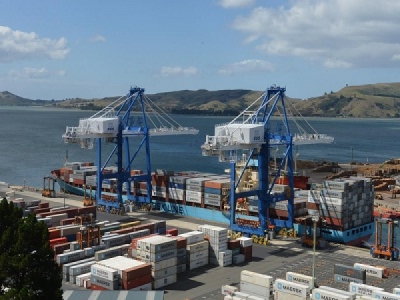
Posted on July 19, 2016
By Simon Hartley, Otago Daily Times
Larger container ships are not on the horizon for Port Otago soon, but shipping giant Maersk says it remains an option, dependent on volumes and customer demand.
Port Otago’s current channel dredging operations now allow the existing vessels of Maersk, its largest customer, to load more containers than usual, but there are no plans yet for larger vessels, in the range of 5500 to 8000-TEU’s (twenty foot equivalent container units) to visit.
Maersk announced this week the maiden visit of a 9500-TEU ship to Tauranga, the largest container ship to visit a New Zealand port.
Maersk’s managing director of Oceania, New Zealand and Australia, Gerard Morrison, was asked if other New Zealand ports could also expect larger-ship calls in the near future.
“We’re well aware of Port Otago’s efforts dredging.
“It’s already allowed us to load more,” he said of the inaugural heavier loading of Laust Maersk in February, and all its other 4500-TEU vessels since then.
While there were “no definite plans” at present to have larger vessels visit Port Chalmers, Mr Morrison said “there will be no [service] reduction to Port Otago … and it’s business as usual”.
He said despite the dairy downturn, volumes, as opposed to pricing, had not been as badly affected for the shipping lines.
“After the downs we should see some ups and get back to business,” Mr Morrison said.
He said while a number of larger ships could be hosted by Port Chalmers, it “might struggle” to accommodate the 348m length of the 9500-TEU ship visiting Tauranga, which may visit in late September or early-August.
Port Otago’s chief executive Geoff Plunket said the channel deepening was designed for container ships of 8000-TEU, about 320m-330m in length, which required two tugs in attendance.
“For our trade we have a balance of services … and options of services for exporters,” he said of routes to North America, Singapore and north Asia destinations.
He noted Port Chalmers could accommodate the maiden visit of the 348m-long cruise ship Innovation of the Seas in December, because cruise ships were lighter, had less draught and were self-manoeuvrable with side-thrust propulsion.
Port Otago’s $30million ‘Next Generation’ dredging programme has completed phase one to a depth of 13.5m and phase two to 14m is to be completed within about 18 months, all to cater for larger shipping.
The programme has included larger cranes, wharf strengthening, new warehousing, and new tugs in recent years, but also as part of upgrading and maintenance.
Mr Plunket said phase two dredging started in April. Two crews were working continuously, 6am Monday to 6am Friday, and the job was scheduled to be completed by about September-October next year.
Because of Maersk’s planned call to Tauranga, the Kotahi joint venture between Fonterra and Silver Fern Farms this week launched a new weekly service to Asian markets.
The 9500-TEU Maersk vessel will depart South America’s west coast, then make one stop in Tauranga, before heading to ports in north Asia, including China, Japan, and Korea.
“South America is a very important market. It was closed to people but is now open,” Mr Morrison said yesterday.
The service will operate through the Port of Tauranga, where a $350million port expansion and dredging operation will allow visits by a ship capable of carrying more than twice the usual number of containers seen on cargo ships operating through New Zealand, BusinessDesk reported.
The South American and New Zealand cargoes are complementary primary produce loads requiring refrigeration, which the ships to be used on the run are well-equipped to provide.
The new service will effectively replace the current Triple Star service, which has been operating a dedicated New Zealand-Asia route on a roughly fortnightly basis, and is a direct product of collaboration with Maersk under a 10-year agreement signed two years ago, Kotahi’s chief executive, David Ross, told BusinessDesk.
However, cost savings are not a feature of the improved timetable. International freight rates already deliver negative returns for much of the global shipping industry.
Instead, the new route represented an investment in a sustainable and more regular service for New Zealand exporters, Mr Ross said.
The ships were more fuel-efficient than the 2000 to 4500-TEU-sized vessels which commonly service New Zealand ports and would cut carbon emissions between New Zealand and Asian ports by about 22%.
Mr Ross said Kotahi did not expect the route to attract any more cargo than already moves on the Triple Star service at first, although he expected it would begin to attract new sources of freight over time.
Kotahi provides export services for more than 40 companies exporting a wide range of primary and other products to about 440 ports around the globe, BusinessDesk said.
Source: Otago Daily Times





